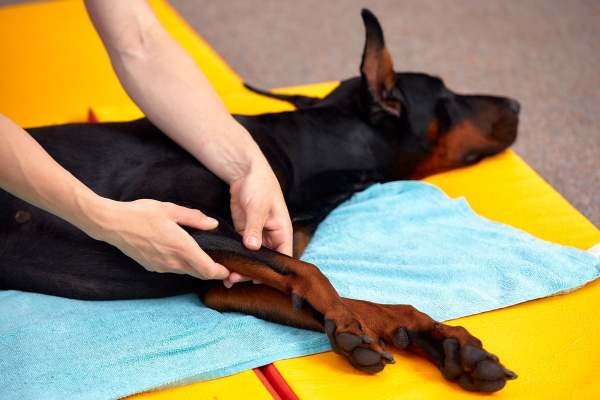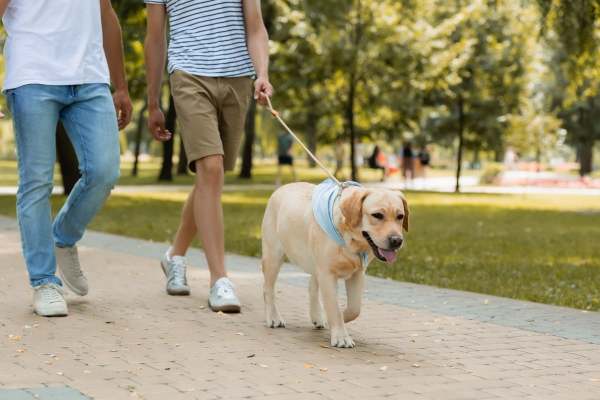
Almost everyone is familiar with sore muscles, but can dogs also experience this pain? Pet owners must know the symptoms and what they can do to treat sore muscles in dogs.
Can my dog get sore muscles? Almost everyone is familiar with sore muscles, but can dogs also experience this pain? © 123RF/ronnarong
Almost everyone is familiar with sore muscles, but can dogs also experience this pain? © 123RF/ronnarong
Yes, dogs can get sore muscles, too.
Although a dog's body looks very athletic and is designed for vigorous activity, their muscles can be overused.
This causes fine tears in the muscle tissue, which is why furry friends then want to move as little as possible.
Sometimes they even react sensitively to touching affected areas.
It is therefore advisable to give dogs adequate exercise, taking their fitness into account.
Especially after a break in activity, dog owners should keep an eye on when the first excessive romp should come to an end.
You should be even more careful if you want to exercise with a dog: cycling or jogging with a dog should be adapted to the animal's fitness level.
You can find out how to recognize, treat, and prevent muscle soreness in dogs below.
How can I tell if my dog has sore muscles? 4 SymptomsIs a dog just tired from yesterday's activity, or is he really in pain? Why does he suddenly twitch when you pet his chest or leg? Is he injured, or is this just a symptom of sore muscles?
Many dog owners are unsure and are looking for answers. The following symptoms are classic signs of muscle soreness in dogs.
 If the dog wants to move as little as possible, this may indicate sore muscles. © 123RF/tkatsai 1. Stiff movements
If the dog wants to move as little as possible, this may indicate sore muscles. © 123RF/tkatsai 1. Stiff movements
If your furry friend is suddenly sluggish after a lot of physical activity, shows a change in posture, or demonstrates a weak gait, you can conclude that they have sore muscles.
Many dogs are also tired and don't want to move during periods of soreness, but if they have to do so to eat or relieve themselves, they tend to do so cautiously and stiffly.
2. Reduced mobilityStanding up, climbing stairs, and lying down suddenly look very cumbersome? This is mainly due to sore muscles in dogs, because the limbs hurt when the muscle groups that have been overused are activated.
If your dog's sore muscles are very intense, even touching the affected parts of the body can cause pain, which is manifested by twitching, flinching, whimpering, howling, or even aggression on the part of the pup.
4. Loss of appetiteIf the discomfort caused by sore muscles is so intense, dogs can even react with a temporary loss of appetite. They feel generally unwell and tired, so they actually ignore their food.
Important: If you are unsure whether a dog really just has sore muscles or is seriously ill, you should consult a vet. You know your dog best and should always listen to your gut feeling.
What can you do for sore muscles in dogs? 6 tips If a dog has sore muscles, massages can help. © 123RF/gerain0812
If a dog has sore muscles, massages can help. © 123RF/gerain0812
Treating and preventing muscle soreness in dogs is similar to what works well for humans:
Treatment measures1. Adapt their exercise to the pain
If your furry friend has sore muscles, then only take him for short walks and increase the activity slowly to avoid overexertion. Short exercise sessions loosen the muscles and support the recovery process.
2. Balanced diet
Even with a temporary loss of appetite, a dog needs to eat and drink enough. High-quality proteins and complex carbohydrates are very important for active four-legged friends.
3. Cooling
Sore muscles can be alleviated by applying cool compresses. This can be done by wrapping a cool pack in a small towel and placing it on the affected area of the dog's body. A dog cooling mat is also suitable for this purpose. A four-legged friend can then lie on the areas that are causing it discomfort.
After consultation with a vet, cooling ointments or gels can also be applied.
4. Massages
Gentle massages can provide relief and promote the recovery process. They stimulate blood circulation, relieve tension in the muscles, and promote the healing process. However, too much pressure and too much friction should be avoided, and attention should be paid to the dog's reactions when massaging.
If he starts to tremble, howl, twitch, or otherwise wants to withdraw from the massage, then it is not (currently) an ideal treatment.
Preventive measuresTo effectively prevent muscle soreness in dogs, there are two key things to remember:
1. Increase activity moderately
A dog's physical activity should not be sudden and intense, but gradual. Whether it's long walks, joint endurance, or targeted dog sports, the training intensity should be increased moderately so that muscles can adapt and strengthen.
2. Time to rest
Those who exercise a lot also need sufficient recovery time. This is also the case with dogs. Therefore, you should never overtax a dog, give it a species-appropriate place to retreat, and then let it sleep – even if the snooze lasts until the next morning.
Conclusion: You can prevent and treat sore muscles in dogs A warm-up for the muscles can prevent muscle soreness in dogs. © 123RF/lightfieldstudios
A warm-up for the muscles can prevent muscle soreness in dogs. © 123RF/lightfieldstudios
Dogs are made to move a lot, to romp around extensively, and to run long distances. Nevertheless, you should introduce a dog to physical activity in moderation to prevent sore muscles. Steadily increasing the distance of walks is ideal for this.
If it has been too much and the otherwise agile pooch suffers a nasty muscle ache, cooling, massages, and rest can help with regeneration.
It is always important to respond to a dog's reactions and consult a vet if lethargy or apparent pain persists.